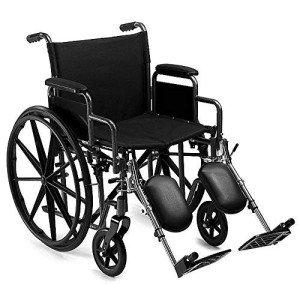Bariatric Wheelchair Seat Width
Seat Width
Having the proper seat width is very important to wheelchair users who spend longer periods in their chairs. Too narrow a seat will trigger pressure on the hips and thighs which could lead to sores or pressure points. Having too broad a seat can likewise make it challenging for the user to reach the hand rims to move themselves or maneuver in small areas.
To measure the right seat width a person would rest on a chair usually and have their measurement taken throughout their lap at the best point which is normally their hips. A wheelchair determining tape can be utilized to determine this, however a lawn stick is preferred as it avoids people from wrapping the tape around their hips which would provide an inaccurate result.
The standard wheelchair seat width is 16" (narrow grownup), 18" (standard adult), and 20" (broad grownup). For bariatric clients, a 24" seat is readily available. This durable additional large bariatric wheelchair from Medline features swing-away footrests, a carbon steel frame with rust- and chip-resistant chrome plating, and easy-to-clean vinyl upholstery. It has a weight capacity of 500 pounds.
Seat Depth
Traditionally, the seat depth of a bariatric wheelchair was included 2" to the measurement taken at the user's largest point (typically their hips). This was suggested to accommodate additional layers of clothing that might be used throughout cold weather condition. Nevertheless, this practice is ending up being less typical as wheelchair users have the ability to spend more time inside your home and are not wearing long coats. This makes the seat depth of a chair less important when picking a bariatric wheelchair. Nevertheless, it is still important to pick a choice that offers appropriate support for larger users.
The Medline folding extra wide bariatric manual wheelchair features a comfortable 24" seat width and a sturdy slide tube silver vein frame. bariatric wheelchair scale has an adjustable axle and tool-free elevating legrests.
Seat Height
When it pertains to identifying the proper wheelchair seat width you must always measure from the user's best point which is typically their hips. You will likewise need to consider whether the user is going to be using a winter season coat as this might add 2" to the width needed.
When a wheelchair remains in use it should just be operated on level surfaces with the wheel locks fully engaged. This is to avoid the chair from having the ability to move inclines that are 10 degrees or higher. It is likewise essential to keep in mind that any activity that might move the center of mass in the chair ought to be made with care. This consists of reaching for items that need the person to lean out of their seat or trying to stand up from it.
Whenever you have the chair in use it is suggested that you frequently check it for damage and oil any areas that are considered essential. For example, the casters ought to be oiled by removing the caster fork and using a multi-purpose grease to apply to the caster stem bearings. Also, bariatric wheelchair 26 inch seat can be adjusted by loosening up the bolt and after that moving them to the desired position. This permits the feet to sit comfortably on the footplate and prevents any pressure points from forming. This can be very unpleasant for the user and if left ignored, can lead to push sores.
Weight Capacity
Bariatric wheelchairs are created to support more weight than standard wheelchairs. This makes them stronger and better equipped to handle falls. They are likewise usually larger and larger, making them less maneuverable in tight spaces than basic wheelchairs. They require vehicles with unique ramps and lifts to pack them, in addition to drivers who know how to finest transport them from one area to the next.
When picking a wheelchair, consider its weight capacity as it will be the primary determining consider whether it will accommodate your traveler's requirements. The weight capacity of the chair is frequently noted as a fixed load, meaning that it suggests the quantity of weight the chair can comfortably hold while stalling. Nevertheless, some manufacturers likewise list an active load that is based upon a drop test and can mimic the effect of somebody sitting down in the chair. This may be a more dependable measurement of the weight limit, depending upon your needs.

If you plan to perform activities that shift your center of gravity in the seat (such as reaching for things), make certain to have front casters pointed in a forward direction and wheel locks engaged so the chair will not topple. Likewise, check that casters are oiled routinely to prevent excessive wear and abrasions. The lubrication procedure involves eliminating the fork, separating the caster from the wheel, and greasing the caster stem bearings with high-quality multi-purpose grease.
